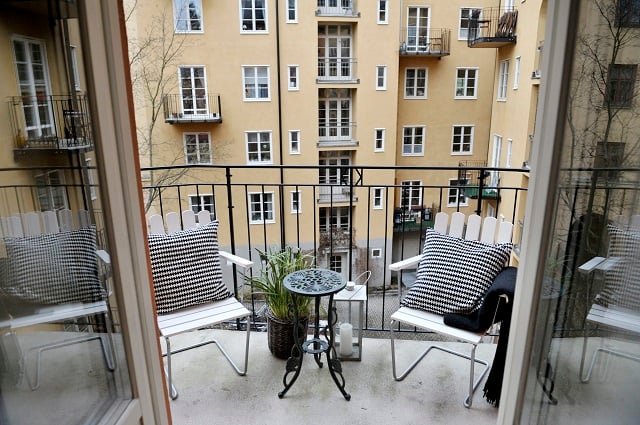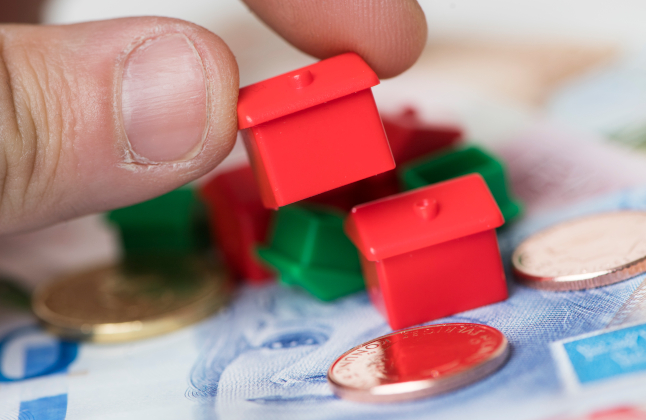How do mortgages work in Sweden?
Your mortgage is a long-term loan allowing you to buy a property – the Swedish word is bolån, literally meaning “living loan”. Because housing prices are high, it’s usual to put down a small amount of the total cost (your deposit or kontantinsats) and borrow the rest from a bank, which you pay back in agreed instalments over several years.
In Sweden, the first step of the process is getting a lånelöfte, literally a “loan promise”. You can do this either at the start of your house-hunt or when you’ve already got a specific property in mind that you’d like to buy.
It’s a good idea to do this early on in the process, because it can make it quicker to get the loan once you actually need the money, ensuring you don’t miss out on your dream apartment since the buying process is relatively fast-paced in Sweden. However, you should already have an idea of your budget when you apply for the lender’s note, because that will influence how much the bank will agree to lend.
If you’ve still got questions on how the rest of the house- or apartment-hunting process works, check out our guides below first:
What do I need in order to get a mortgage in Sweden?
You’ll need a Swedish personnummer and proof of stable finances in Sweden, and you’ll be subject to a credit check. This means that you’ll usually need a history of employment and paying tax in Sweden, although some banks are more lenient than others when it comes to, for example, self-employed people or recent arrivals.
If you still have Swedish student loans to pay back, this will be taken into account when calculating your mortgage, however student loans in other countries are not usually factored in.

Photo: Fredrik Sandberg/TT
The exact amount you can borrow depends on how many of you are in the household, your income(s), what kind of employment you have (permanent is more secure), your deposit amount, any other loans you have, and how much your monthly fee (avgift) will be if you’ll be buying a property that belongs to a housing association (BRF) or the size of the home if you’ll be going for a detached house.
How can I get the best rate?
Your mortgage is very likely to be your single biggest household cost, so it’s worth shopping around to make a saving. Remember, even a small decrease in terms of percentage points could add up to thousands and thousands of kronor over time.
Using price comparison tools such as Compricer or Konsumenternas is a good start. Next, call up several of the banks which seem to offer the best deals; it’s a good idea to prepare for these calls by doing some sums beforehand, comparing the different deals on the market so you can pit them against their competitor and show them you know what you’re talking about.
Members of trade unions are offered discounts at several banks, so be sure to ask about this if you’re eligible, and some banks offer discounts on mortgage interest for certain types of homes, for example energy-efficient properties.
And there may be room to negotiate a better offer than the one offered online, especially if you set up a meeting or phone call. If you’re an existing customer at one bank but they haven’t offered the most competitive rate, it’s worth seeing if they’ll match the better rates you’ve found in exchange for you taking out your loan with them.
But watch out for offers that look attractive but come with hidden costs. For example, banks usually require that you have a current account with them in order to take out a mortgage there, so look out for any requirements such as expensive cards. Don’t forget to include any extras when calculating your monthly costs with different banks.
Make sure you know exactly how long any discount or reduced rate will apply for. Why not set a calendar reminder for this date, so you’ll be ready to renegotiate once the original offer expires? Either way, make sure you renegotiate your terms regularly so you’re confident you’re still getting the best deal.

Photo: Tomas Oneborg/SvD/TT
What do I need to know about joint mortgages?
If you’re buying with a partner, you’ll likely be sharing the mortgage. Remember that two people who live together as a couple in a shared household are given the legal status of sambo (cohabiting partners) in Sweden.
This means that any property you purchase together with the intention of sharing as a couple may be subject to 50:50 division in the event of a breakup, even if one partner paid a larger share of the deposit. Some couples choose to draw up a written contract (with assistance from a lawyer) which states what would happen if they split up.
Exactly how much do I need to pay?
When you buy a house in Sweden, you’ll usually need to pay a minimum of 15 percent of the total price as a deposit (kontantinsats), so the remaining amount will be covered by the mortgage. You’ll pay back a certain amount each month over a fixed length of time, often 25 years.
If your deposit is less than 15 percent, then your mortgage will be split into two different loans, including one that covers the cost up to 15 percent of the total price which will typically have a higher interest rate and a shorter term.

Photo: Jessica Gow/Scanpix/TT
The rest of your mortgage might be fixed rate (bunden), where the interest rate is set for a longer time of up to ten years, or it could be variable (rörlig), which means it could change as often as every three months, depending on the interest rates at the time.
A fixed rate is usually higher to begin with, but you have the stability of knowing it won’t suddenly rise if overall interest rates go up. You can also hedge your bets by splitting between the two, so that part of your mortgage is fixed rate and the other part is variable.
If you have a variable rate, it’s usually possible to overpay the mortgage. If you’re in a stable financial position with no other loans or debts, this is worth considering in order to give yourself a buffer in case your finances change in future or interest rates rise, increasing your overall total cost.
We’ve talked about ensuring your interest rates are as low as possible by shopping around, but unlike in some countries it’s not possible in Sweden to pay only the interest each year. Since 2016, there’s a law that property owners must pay off at least two percent of the total loan each year, on top of interest, until a loan reaches at least 70 percent of the value of the property, then one percent until it reaches 50 percent. That means that if you put down a 50 percent deposit, you wouldn’t need to amortise (amortera) the loan at all.
The rule that property owners have to amortise was put on hold until August 2021 due to the coronavirus crisis, but returned in September 2021.
In any case, don’t forget that in addition to your mortgage or interest rate itself, you’ll also be paying a monthly avgift (fee) to the housing association (BRF) if your apartment or house belongs to one. This is calculated separately from the mortgage as it’s a deal between you and the BRF, not you and your bank, but don’t forget to factor it in when working out the level of mortgage you can afford.
How do taxes affect this?
Here’s the good news. Property owners in Sweden are eligible for a tax deduction which means you can reclaim 30 percent of the interest payments up to a total value of 100,000 kronor per year.
You can either get this back each month, giving you extra disposable income throughout the year (this option requires you to speak to your payroll department at work) or get it returned as part of your annual tax return.
What should I keep track of in the Swedish economy?
Sweden’s central bank (the Riksbank) has increased key interest rates in recent months, meaning that banks have raised their mortgage rates to match. This means that the days of low or no-interest mortgages may be a thing of the past.
Essentially, you will have to decide whether you are comfortable paying a variable rate, which could continue to rise, or a fixed long-term interest rate, which will fix interest at the level it is now, thereby protecting you against further unexpected rises in interest rates. However, if interest rates go down in the future, your fixed rate will stay the same.
Expert economists tend to advise against opting for a fixed interest rate on your mortgage, since a variable rate means you can take advantage of a competitive market, but it’s really a matter of preference.

Photo: Aline Lessner/imagebank.sweden.se
If you’re unsure about the best option for you, it could be worth speaking to a consumer adviser. And before you take out a mortgage, you should do some calculations to ensure you’d still be able to pay off the mortgage even if interest rates were to rise further. It’s possible to do this by playing around on an online mortgage calculator, or speaking to your bank if you’re confused.
As well as following developments in the Swedish economy, it’s just as important to keep up to date with any changes to the financial state of your BRF. Most BRFs have loans themselves, which are typically higher for more recently built apartments, and the higher the loan, the more vulnerable the BRF is to national changes in the interest rate.
If the BRF is doing well financially (bringing in plenty of money from the avgift to cover its costs), your avgift should stay relatively low and you may even be given some months’ free rent. But if the BRF starts to struggle (for example, if costly renovations are required) your avgift could go up.
This is completely separate from your mortgage, since that’s a repayment plan directly between you and your bank, but it does affect your total monthly housing costs.
Did you find this useful? Do you have more questions? Let us know.




 Please whitelist us to continue reading.
Please whitelist us to continue reading.
Any more information on deposits less than 15 %? I went to my bank last week to ask and they told me 15 % is required. Are any other banks different?
SBAB are often willing to provide a personal loan to bridge the gap to the “required” 15%.